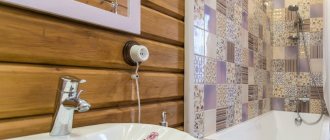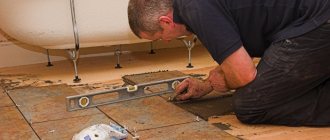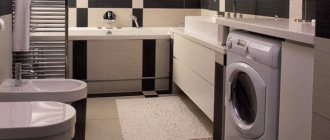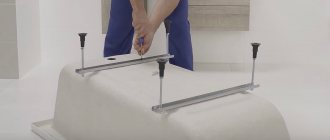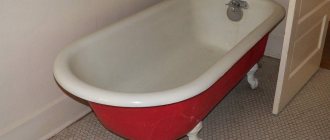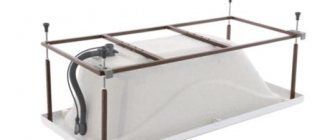Forced ventilation is designed to provide a comfortable microclimate in the bathroom. High humidity and sudden temperature changes lead to the formation of condensation and the development of pathogens. Before connecting a bathroom fan to a switch, you should evaluate the operating conditions and select a model of suitable power.
Choosing a fan for the bathroom
Household models have small dimensions and low power compared to units for industrial purposes.
According to the design and method of intake of the air mixture, they are divided into 2 types:
- Axial.
- Radial.
The first are equipped with blades that capture air and direct it parallel to the central axis of the device. Radial fans have a special impeller. It is designed to change the direction of atmospheric flow.
Axial models are the most common in everyday life. Their installation does not require special skills or technical training. Fans are classified according to the type of installation: duct and overhead.
The first option is characterized by higher performance and low noise. Such models are mounted in air ducts. In a private house you can install any type of fan, but in a city apartment - only an overhead fan.
When choosing a suitable device you should consider:
- Noise level.
- Power.
- Bearing type.
- Moisture protection class.
The performance rating and noise level are indicated in the supplied user manual and printed on the packaging. Depending on the size of the bathroom, it is recommended to purchase a device with a capacity of 50-250 m³/h. The noise level that is comfortable for human hearing is in the range of 25-30 dB. Since the fan will have to operate in conditions of high humidity and sudden temperature fluctuations, it is advisable to give preference to a model with a protection class of at least IP44.
Air exchange in rooms
For a long time, the use of natural ventilation was considered the most optimal way to ensure air exchange. Until now, most houses use precisely this principle, since the system is characterized by simplicity of design and does not require energy to move air volumes.
The air exchange system solves a number of important problems:
- supply of fresh atmospheric air;
- removal of products of incomplete combustion of household gas;
- elimination of unpleasant odors;
- removal of carbon dioxide;
- reduction of indoor temperature;
- Humidity regulation.
The movement of street air into rooms occurs due to the difference in pressure in the rooms and outside the house. When the windows are open, the movement of air masses increases significantly - this is how ventilation occurs.
Natural ventilation was developed through the widespread use of windows with wooden frames. The window openings had a sufficient number of slots to ensure a change in the required air volumes. The situation became significantly more complicated with the advent and widespread use of double-glazed windows, the design of which provides for the use of highly effective seals. Once the window opening has become sealed, it no longer allows outside air to pass through, which can completely disrupt the operation of the ventilation.
More expensive models of modern windows are equipped with special valves for ventilation. However, the cost of such designs encourages buyers to abandon advanced models and give preference to cheaper ones.
As a result, the first to suffer are the rooms in which ventilation outlets are located according to the project:
- Kitchen. It is especially important here to remove household gas combustion products if the house is gasified. The health and safety of a person’s stay indoors during the cooking process depends on this. The operation of the four burners of a gas stove requires the exchange of at least ninety cubic meters of air per hour. An exhaust fan cannot always cope with this volume, but properly selected exhaust ventilation will certainly solve the problem.
- Bathroom. Using large volumes of water creates increased humidity. Ineffective ventilation not only reduces the usability of the bathroom, but also contributes to the appearance of mold, which actively multiplies in a warm and humid environment.
- Toilet. This requires increased air exchange to ensure freshness.
In addition, good operation of ventilation ducts ensures the removal of air from living rooms, since street air masses first pass through them, and only then enter the air ducts of the kitchen, bathroom and toilet.
There is another problem that negatively affects air exchange. Over a long period of operation, ventilation ducts accumulate on their walls a significant amount of grease, dust, soot and other contaminants. The nearest air duct outlet in the apartment can be cleaned yourself, but the vertical ducts are inaccessible.
We recommend that you read: How to choose and install a ventilation grill for a window sill
In addition, residents do not have the right to maintain them themselves—cleaning can only be done by an organization entrusted with the operation of the building. Many companies ignore this issue, which is why ventilation ducts remain uncleaned for decades. As a result, you can often encounter difficulty in air removal even with the windows open.
The problem of poor quality air exchange can be solved by switching to forced ventilation. The easiest way is to install conventional fans in the standard air duct openings.
Installation features
The fan is connected to a two-wire wire. First, remove the front panel from the device. A groove is laid from the distribution panel to the ventilation hole. It must be strictly vertical or horizontal, without inclined lines.
The groove for laying electrical wiring is located no closer than 10 cm to the doorway. The cable is fixed with alabaster or cement mortar. The power supply line can be run inside the corrugated pipe.
The fan terminals are marked in English:
- L - phase.
- N - zero core.
- T - for connecting the signal wire. Used in models with a timer.
The veins vary in color. Zero is blue, the phase is in brown or white insulation. They must be correctly connected to the fan terminals and check the reliability of the contact. There are 4 holes for screws or self-tapping screws on the device body. Fastening elements are included in the delivery set. The fan can also be mounted on tiles without drilling. Silicone glue is suitable for this. You can use liquid nails.
On the wall
The device is applied to the surface. Use a pencil or marker to mark the drilling locations. An impact drill or hammer drill is suitable for forming mounting holes. It is necessary to use drills with pobedite tip. After drilling holes of the required depth, plastic dowels are driven into them.
The hood is inserted into the vent and secured with the supplied screws. Then you can start connecting the device. The scheme depends on the characteristics and functionality of the model.
Algorithm for wall mounting without drilling:
- The surface of the wall at the attachment point is cleaned.
- Silicone glue or liquid nails are applied along the contour
- The device is applied to the opening of the ventilation duct.
- To check the horizontal level, use a level.
- The fan is fixed with tape for 2-3 hours.
The final stage is to supply power and return the decorative panel to its place.
On the ceiling
A suspended or suspended ceiling system is suitable for installing an exhaust fan in a bathroom. This placement is rarely used in private homes, where the air duct can be led into the attic. In such a building, it is advisable to install a powerful duct device, which ensures rapid renewal of the atmospheric mixture in large rooms.
With a suspended or suspended ceiling system, the task becomes somewhat more complicated. Often the space for installing an exhaust fan in the bathroom is laid out at the design stage of the house. The ventilation grille or cooler is attached to the plasterboard panel with butterfly dowels.
The device is fixed on the polyvinyl chloride film using a pre-installed rigid base. When a suspended ceiling is installed, communications are pulled through a pre-prepared hole or carried along the base surface and hidden with a cable channel.
Diagnosis of problems with the hood in the bathroom
Special diagnostics aimed at checking draft will help to assess the condition of the ventilation system. The event is carried out in several stages using improvised means or special devices.
It is better to check the operation of natural ventilation in the cold season. Before this, it is recommended to ensure an influx of fresh air: open the window or set the windows to ventilation mode. In sanitary rooms, the door should be opened slightly.
The easiest way to diagnose at home is a fire test. You need to take a lit match, lighter or candle and carefully bring the flame to the grille of the ventilation duct, which removes exhaust air from the bathroom
The functionality of the ventilation ducts is assessed by the behavior of the flame brought to the grille:
- deviates towards the grille - the system is working, the draft is normal;
- remains in the same position - there is no traction;
- deviates towards the room - there is a reverse draft.
It is worth considering that this technique is unsafe and is highly not recommended for use by gas service specialists. If there is a leak in the house, gas accumulates in the ventilation shafts. Under such circumstances, an open flame may cause a fire or explosion.
A safer way is to test with a thin sheet of paper. As in the previous case, it is brought to the ventilation hole. The paper is taken by the lower tip and held in a vertical position near the grate.
If the paper is strongly attracted to and held by the grille, the ventilation is working well. Short sticking or slight deviation towards the hole indicates weak traction. If nothing happens and the sheet remains motionless, the system is faulty. Paper pushing away is a sign of backdraft
The outflow of air can also be felt through tactile sensations. To do this, wet your hand and bring your wet palm to the vent. The presence of air flow is determined by a cooling blow.
These diagnostic options will only give a general idea of the performance of the ventilation in the bathroom. You can obtain a quantitative assessment of efficiency and determine whether the state of the system complies with standards using special instruments - anemometers.
Anemometers measure the speed of air flow in a ventilation duct. They are often used by professionals, but simple models are quite suitable for use at home.
The device is brought to the ventilation grill at the distance specified in the instructions. After a few seconds, the display shows the air flow velocity ( V ). Having fixed the resulting figure, you need to calculate the volume of air passed through the system using the formula:
Q = V x S x 360,
Where
- S – cross-sectional area of the ventilation duct in m²;
- V – air flow speed.
The result is compared with standard parameters. The optimal value for a bathroom is 25 m³/h. The norm for combined bathrooms should be twice as much.
We also recommend that you familiarize yourself with the rules for checking the operation of ventilation ducts in an apartment.
Connecting a fan without a timer
This connection option is considered the simplest from a technical point of view. The switch is placed in front of the entrance to the bathroom or indoors. It is advisable to install it away from plumbing equipment, where splashes on electrical contacts are prevented.
Plastic axial fans do not have a terminal output for connecting a ground loop. Everything is limited to phase switching with a neutral conductor. Connections are made in a distribution panel or socket box up to 60 mm deep.
To a separate switch
This is the most common connection option.
You will need to perform the following wiring connections:
- the neutral conductors of the ventilation unit and the electrical network are connected and insulated;
- the hood and switch phases are paired in the same way;
- The phase conductor of the electrical network is connected to the input terminal of the switch.
An important condition is the connection of the ground loop.
To the switch shared with the light
It is convenient when the ventilation unit starts at the same time as the lighting fixtures are turned on. The most practical option is to combine it with a two- or three-key switch. A socket box is installed in the corresponding hole. Electrical switching is carried out in it.
The input terminal is connected to the phase conductor of the power supply network. The output contact closes to the phase of the climate control unit. After connection, it is necessary to check the reliability of the connection and the integrity of the insulation. Then the working mechanism is fixed in the socket box and the cover with keys is installed.
Additional fan functions
A fan that is installed in the bathroom may have additional functions. How effective and necessary they are is for the consumer to decide.
The efficiency of the fan is checked as follows:
Motion Sensor
It is installed on the door, so it turns on the fan when it opens. After a certain time (up to 20 minutes), the hood stops working. To start the hood you need to open the door again.
Time sensor
The fan is connected to the light circuit and turns off itself, depending on how long the timer is set. The timer parameters can be set for 10-15-20 minutes of fan operation.
Humidity sensor
The fan is equipped with a hygrometer, which constantly measures the humidity level. When unacceptable values are reached, the fan turns on automatically and runs until a normal humidity level is established.
Advice. Installation of a fan on the hood is possible with an additional shutdown timer function. Never install a fan that turns on by itself - a person must regulate the on/off switch. An automatically turned on hood while taking a bath or shower leads to colds.
Connecting a fan with a timer
Units equipped with a timer are easy to use.
The operating principle of such a device is as follows:
- The fan starts in parallel with the lighting.
- After the light turns off, the unit rotates for a user-specified time, removing exhaust air from the room.
- Then it turns off automatically.
To ensure full functioning of the device, 4 cores are used:
- phase from the distribution panel;
- electrical wire connected to the light bulb;
- ground loop;
- zero core;
For self-installation, it is recommended to purchase a surface-mounted device with the necessary set of built-in sensors - humidity, motion, etc.
To a single-key switch
You can turn on lighting and ventilation with one button, but with a slight delay in starting the climate control unit. Some models are equipped with an electronic timer. Such devices provide the ability to select a functional mode. Their switch is implemented in the form of 3 pin contacts. Two of them are closed with a jumper - a special jumper. One mode is called "toilet". To activate it, the upper and middle contacts are closed.
The meaning of this mode is that when power is applied, the motor of the ventilation unit starts immediately. The second mode is called “bathroom”. The light turns on immediately after pressing the switch key, and the cooler starts working with a set delay. In this mode, the unit will start only if the time interval between turning the lighting on and off is at least 90 seconds.
To two-button switch
When connecting an exhaust unit to a two-key switch, the phase is interrupted at one of the contacts. This method of electrical switching allows you to turn on ventilation and lighting separately. The neutral and phase conductors of the power supply system are closed at the corresponding outputs of the terminal block of the device. The control phase is located on one of the switch keys. It is connected to the timer contact of the exhaust device.
The operation of the unit is controlled and the operating mode is set through it. This wire is color coded brown. You can use the green-yellow wire, which is not used for this type of connection, which is responsible for grounding. In this case it does not start on the cooler. To connect the exhaust unit to a two-button switch, it is recommended to use a three-core power cable. This will allow for separate or paired operation of lighting and ventilation.
Types of exhaust fans
All devices for forced exhaust in the bathroom are divided into several types:
- By launch method. Without control and with control via sensors and remote control.
- At the installation site. Wall-mounted fans are often used for exhaust hoods; they can be easily removed if necessary, for preventive maintenance or replacement.
But there are also ceiling ventilation devices; they have many advantages:
- high productivity;
- easy installation;
- the ability to hide the fan housing behind a false ceiling;
- nice design.
Ventilating devices for exhaust hoods are also divided according to installation depth. There are overhead fans and those built into the wall at one level.
- By type of construction.
In order to understand which fan is best suited for bathroom and toilet hoods, you need to understand their structure.
There are four of them in total, but only two types are used in everyday life:
- Axial. The most popular model for use in bathrooms, since its installation is the easiest. The device is a cylinder, inside of which there is a motor with blades on a shaft. You just need to insert it into the ventilation shaft and secure it.
- Radial (centrifugal). It received this name because of the principle of its operation when air masses rush outward due to centrifugal force.
There are also channel devices. These ventilation devices are used for exhaust in hospitals, schools, kindergartens and other institutions.
Industrial installations are also used. As the name suggests, such fans are used in production workshops and factories.
Connection errors
Electrical safety regulations prohibit installing a switch inside the bathroom. In apartment buildings with an improved layout with large bathrooms, you can install electrical devices near the entrance away from the plumbing equipment. A common mistake is laying a cable without a corrugated insulating channel.
The rules also indicate that connections without appropriate protection are prohibited in areas of high humidity. Due to leakage currents, false alarms of RCDs are regularly observed. Contact of water condensation on electrical contacts will lead to rapid equipment failure. Only devices powered by extra-low voltage may be installed in the bathroom.
The exhaust unit must not be connected to the internal wiring of lamps located in the bathroom. For the ventilation device to function correctly, voltage must be constantly supplied to its control board. A common mistake is the use of various remote sensors. It is not recommended to place them in the bathroom without moisture protection.
Reasons for removing the device
After several years of use (or sooner if there is smoking in the bathroom or toilet), the efficiency of the exhaust fan decreases. The reasons for the problems include:
- contamination of the device blades, which reduces the draft of the ventilation system;
- deterioration of lubricant characteristics, due to which the impeller rotation speed decreases and the noise level increases;
- wear of individual elements of the device requiring replacement.
Due to the decrease in the speed of air passing through the fan blades, the humidity in the bathroom or toilet increases, and the conditions become less comfortable. The situation can be corrected by periodically performing preventative maintenance on devices and, if necessary, replacing them with new ones. When replacing, ventilation efficiency can be improved by choosing a more efficient model.
You can know that it is time to clean or replace the fan by the appearance of squeaks and noises, due to which the device becomes a source of acoustic discomfort. In most cases, the air in such a situation becomes not very fresh, and the engine overheats, increasing the risk of failure of the device. Therefore, timely maintenance not only improves air exchange and reduces noise levels, but also increases the service life of the fan.
Signs and causes of ventilation malfunction
When the ventilation system does not cope with its functions, problems arise. This affects the comfort of residents and can lead to unpleasant health consequences.
Impaired air exchange in the bathroom can be judged by the following signs:
- increased air humidity;
- accumulation of abundant condensation on mirrors and walls of the bathroom;
- unpleasant musty odors;
- rust formation on metal surfaces;
- destruction of finishing materials and “swelling” of furniture coverings;
- the appearance of fungus and mold on the ceiling, walls and corners;
- the hood in the bathroom blows in the opposite direction;
- loud noise from air ducts.
Before troubleshooting, you need to find out the specific cause and understand where exactly intervention is required. There can be several reasons for ventilation failure. The main and most common problem is clogged ventilation shafts. Insufficient air flow also causes traction problems.
Frequent culprits of impaired air flow are tight doors and high thresholds in bathrooms. When using such structures, draft will only be present when the doors are open. Unpleasant odors and steam begin to accumulate indoors
This usually happens after installing sealed PVC windows with double glazed windows and additional sealing contours. They impede the flow of fresh air flow, significantly weakening draft.
Failures in the functioning of ventilation also occur due to damage or wear of the exhaust fan mechanisms, clogged filters in the grilles, and corrosive processes. Such factors lead to deterioration of air quality and increase the resistance of channels.
Another reason for poor ventilation is repairs or re-equipment of the neighbors’ system.
There are several possible scenarios for the development of events:
- as a result of modernizing the layout or installing additional equipment, the ventilation ducts are blocked;
- during repairs on the top floor, the shaft becomes clogged with construction waste;
- the creation of a strong forced inflow from below provokes reverse draft, preventing air circulation.
Although these actions on the part of neighbors are not intentional, they are classified as administrative violations, for which a fine is imposed.
Not only renovations in neighboring apartments, clogged air ducts and excessive sealing of rooms can contribute to the reverse draft effect. Of great importance is the correct design of the exhaust system of the house, installation of ducts and additional equipment
The operation of exhaust ducts is negatively affected by significant deviations from the vertical of the air ducts, unsuccessful roof structure designs, and high heat transfer rates of external walls, which insulation can help reduce.
In addition, deterioration in air exchange is often associated with the time of year. Ventilation works most effectively during cold periods. In summer, due to almost the same temperature inside and outside, a so-called “air jam” is created in the room. When external temperatures rise, natural draft always weakens.

